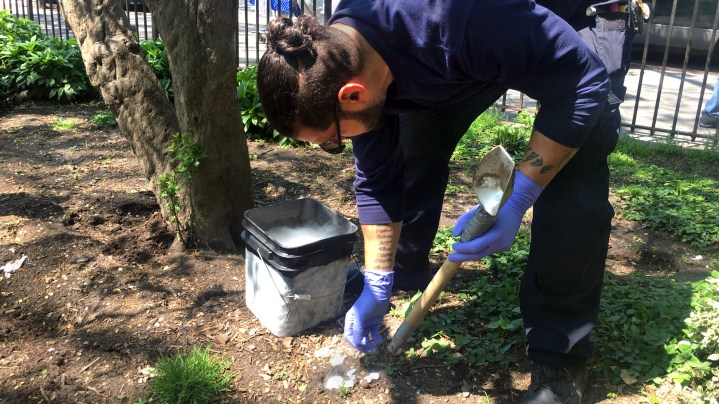
New York City turns to dry ice to control its rat population
New York City turns to dry ice to control its rat population

Urban residents typically do their best to avoid rats. New York City exterminator Joseph Rodriguez seeks them out.
He uses the handle of a shovel to shift the foliage in a neighborhood park, looking for small tunnels at the base of plants. When he finds the smooth opening of a rat burrow, he slides a few scoops of dry ice pellets into the opening, trailing foggy vapors.
“If you pay attention to the burrows that are close by, you’ll see the vapors coming out from the other burrows,” he explained. “That lets us know that they connect.”
Rodriguez works quickly to plug eight burrows in this section of the park, down from 21 burrows in this same area in December. Adrian Ferreiras, an apprentice exterminator, follows behind and shovels dirt on top of the dry ice.
“The dry ice turns into a gas,” explained Jonathan Richardson, who studies urban species at the University of Richmond. “So you have a large amount of carbon dioxide that is surrounding the rats in their colonies and they, essentially, suffocate.”
While dealing with rodents is an icky, potentially unhealthy reality of modern urban life, cities have found a relatively new tool in dry ice. New York City sought to have it approved by the Environmental Protection Agency as a pesticide and used over 14,000 pounds of it last year.
It’s more labor intensive than rodenticide, but it’s more effective when it can be applied to enclosed spaces, such as a network of burrows. Unlike rodenticide, it doesn’t pose a secondary poisoning risk to the birds and other predators that eat rats.
They’re … exquisitely adapted to reproduce, and to reproduce really fast.
Jonathan Richardson, University of Richmond
Chicago, Boston and Washington, D.C., among other cities, are also using dry ice to help control their rat populations. This year, D.C. has budgeted $300,000 to deploy rat birth control throughout the city, trying to get rats to ingest a continuous supply of a liquid contraception to slow or prevent new births.
New York City’s $40 million rat eradication program, launched in 2017, was created to address public health and quality of life issues in the city’s three rattiest areas. In addition to dry ice, it includes rodenticide, replacing some open trash cans with closed containers to prevent rats from feeding on garbage and covering the dirt floor of 70 public housing basements with cement.
“Our goal was to reduce rats by about 70% [in the target areas],” said Laura Anglin, New York’s deputy mayor for operations, who oversees the rat initiative. “We’re getting closer to that. We’re not quite there yet.”
The city is tracking its progress through inspections of private and public property, schools and parks to record burrow counts and other evidence of rats, like droppings or tracks.
Anglin said the city is close to its reduction goal in schools and public housing developments, but parks have been more difficult.
“Parks, we’re probably around 40% [in reduction],” she said. “That’s mainly because we struggled a little bit this winter because, while it was great that it was a warm winter here in New York City, that did not help slow down the growth of our rat population.”
Rats breed less often in colder temperatures.
The mayor’s office had also proposed prohibiting residents from leaving their garbage on the curb the evening before trash day, which gives rats easy access to food scraps while the bags sit out overnight. But that idea met resistance.
“There was a lot of push back from a lot of homeowners and large apartment buildings that thought that would be very costly to do,” said Anglin. “So we weren’t able to do that.”
Cleaning up cities’ hygiene and food waste is probably the most effective way to control rat populations, according to Richardson, of the University of Richmond.
“We know the access to increased food resources is the No. 1 reason many of these pests — ‘pest species’ — are thriving in cities alongside us,” he said.
But he warned that even with robust control efforts, cities are never going to eradicate rats.
“Their gestation rate is only about three weeks, they often have more than a dozen pups per litter and the female can become pregnant within days of giving birth,” he said. “They’re sort of exquisitely adapted to reproduce, and to reproduce really fast.”
There’s a lot happening in the world. Through it all, Marketplace is here for you.
You rely on Marketplace to break down the world’s events and tell you how it affects you in a fact-based, approachable way. We rely on your financial support to keep making that possible.
Your donation today powers the independent journalism that you rely on. For just $5/month, you can help sustain Marketplace so we can keep reporting on the things that matter to you.


















